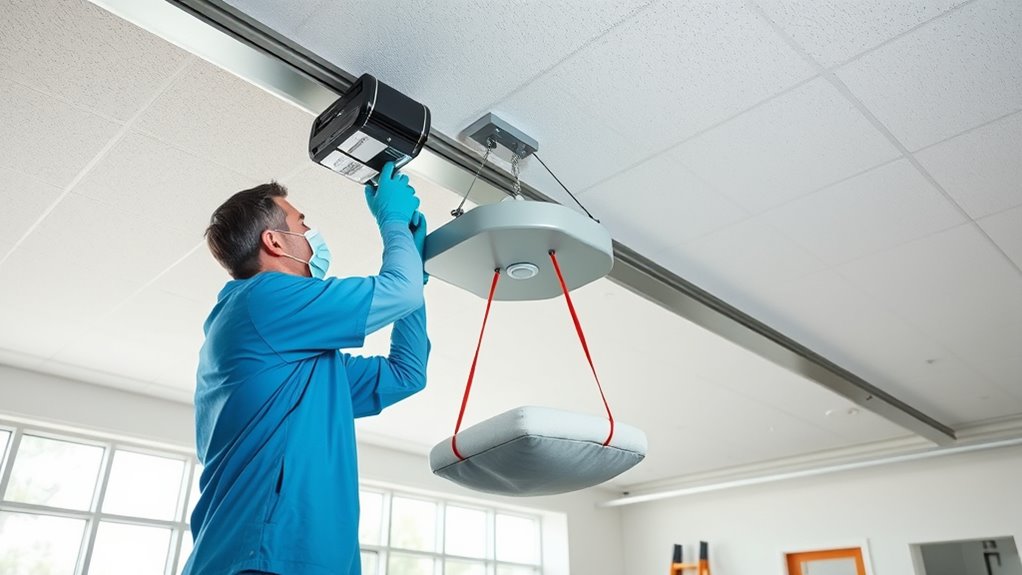To install a ceiling lift, choose a location that supports safe transfers, guaranteeing the ceiling can handle the lift’s weight. Securely mount the ceiling track to strong support beams, and verify electrical connections and safety features like emergency stops. Regular maintenance and proper training for caregivers are essential for safe operation. Following these steps helps ensure reliable, safe use, but exploring the detailed process will help you get everything installed correctly and confidently.
Key Takeaways
- Choose a secure, load-bearing ceiling location supporting the lift’s weight and transfer needs.
- Verify ceiling structure and support beams can handle the lift’s weight through structural assessment.
- Properly mount and anchor the ceiling track following manufacturer instructions for safety and stability.
- Connect electrical components correctly and test all safety features, including emergency stops and locks.
- Train caregivers on safe operation, maintenance, and keep detailed records of inspections and repairs.

Installing a ceiling lift can considerably improve mobility and safety for individuals with limited strength or balance. When you set up this equipment, you’re creating a more secure environment that minimizes the risk of falls and injuries during transfers. It’s vital to pay close attention to patient safety throughout the process, making sure that the lift is properly installed and functions smoothly. A well-installed ceiling lift provides peace of mind for both caregivers and patients, knowing that transfers are safer and more comfortable.
Proper equipment maintenance is essential to keep the ceiling lift operating reliably over time. Regular inspections help detect any signs of wear and tear, such as frayed cables, loose components, or malfunctioning controls. If you neglect maintenance, it could compromise patient safety, leading to unexpected failures during transfers. Establishing a routine maintenance schedule and following manufacturer guidelines ensures that the lift remains in prime condition. This proactive approach reduces downtime and extends the lifespan of the equipment, saving you money and effort in the long run.
When installing a ceiling lift, you need to carefully select the right location. The ceiling track should be securely mounted to support the weight of the patient and accommodate their transfer needs. You’ll want to double-check the structural integrity of the ceiling and support beams, especially if you’re installing the lift in an older building. Proper installation not only guarantees safety but also prevents future issues that could arise from improper anchoring. Additionally, make sure the lift’s electrical components are correctly connected and that all safety features, like emergency stops and locking mechanisms, are functioning properly before use.
Training is another important aspect that enhances patient safety. Once the lift is installed, ensure that caregivers are thoroughly trained on its operation, safety protocols, and emergency procedures. Proper use and understanding of the equipment can prevent accidents and ensure smooth transfers. Always follow the manufacturer’s instructions for cleaning and maintenance, and keep a log of inspections and repairs. This documentation can prove invaluable if questions about safety or compliance arise later.
Frequently Asked Questions
What Is the Maximum Weight Capacity of a Ceiling Lift?
The maximum weight capacity of a ceiling lift typically ranges from 300 to 600 pounds, depending on the model. Always check the specific lift’s weight limits and lifting capacity before use to guarantee safety. Exceeding these limits can cause mechanical failure or injury. You should select a lift that comfortably meets the user’s weight and needs, and regularly inspect it to maintain ideal performance and safety.
How Often Should the Lift Be Inspected for Safety?
You should inspect your ceiling lift at least once every six months to guarantee lift safety. Regular inspection frequency is essential because studies show that equipment failures account for nearly 20% of transfer accidents. During each inspection, check for wear, fraying, or loose components. Maintaining a strict schedule helps catch issues early, preventing accidents and ensuring the lift functions reliably when you need it most.
Can Ceiling Lifts Be Installed in Any Ceiling Type?
You can install ceiling lifts in many ceiling types, but compatibility depends on the structure and ceiling material options. For example, concrete, wood, and suspended ceilings often work well, but you need to assess the ceiling’s strength and support. Some ceiling materials, like lightweight drywall, may require additional reinforcement. Always consult a professional to evaluate your specific ceiling type and material options before installation to guarantee safety and stability.
What Maintenance Is Required for the Lift System?
You need to regularly perform lubrication routines on all moving parts to keep your ceiling lift functioning smoothly. Check and tighten connections, and inspect for wear or damage. Battery maintenance is also vital—charge it as recommended and replace it if it no longer holds a proper charge. These simple steps help guarantee safety, extend the system’s lifespan, and prevent unexpected breakdowns during transfers.
Are Ceiling Lifts Suitable for Outdoor Use?
Ceiling lifts are typically not suitable for outdoor use. Their outdoor durability is limited, and weather considerations like rain, wind, and extreme temperatures can damage components. You should avoid exposing these lifts to the elements, as moisture can cause rust and electrical issues. For outdoor environments, consider specialized, weather-resistant lifts designed to withstand the elements, ensuring safety and long-lasting performance.
Conclusion
Installing a ceiling lift can transform your daily routine, making transfers safer and easier. Did you know that proper lifting equipment reduces injury risk by up to 60%? By investing in a ceiling lift, you’re not only enhancing safety but also gaining peace of mind. It’s a simple upgrade that can markedly improve quality of life for both caregivers and users. Take the step today—your comfort and safety are worth it.








